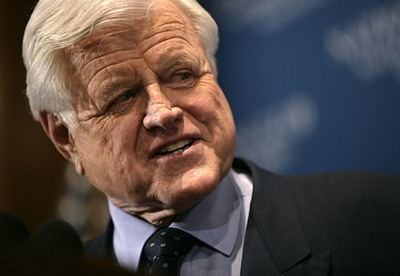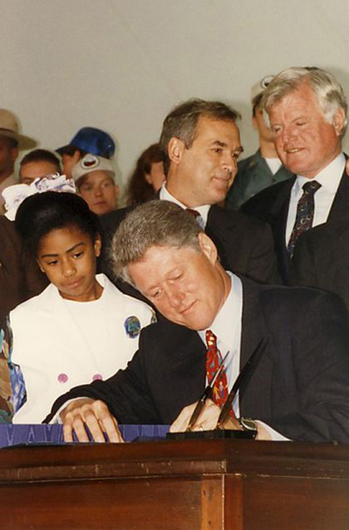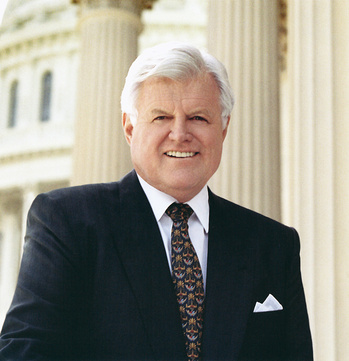 A while back, I wrote a behind-the-scenes book about the passage in 1993 of the law creating AmeriCorps. That national service program is sometimes called the “Domestic Peace Corps,” a reference to the international service program established by President John F. Kennedy.
A while back, I wrote a behind-the-scenes book about the passage in 1993 of the law creating AmeriCorps. That national service program is sometimes called the “Domestic Peace Corps,” a reference to the international service program established by President John F. Kennedy.
As chairman of the Senate Labor and Human Resources Committee, the task for getting Bill Clinton’s proposal through the Senate in 1993 fell to President Kennedy’s younger brother, Ted Kennedy.
I got to watch up close Kennedy’s extraordinary skill as a legislator. Far from being an ideologue, Kennedy was invariably the guy going for the deal — so much so that one Democratic player complained that “[Kennedy was] cut and run, cave and run,” a phrase that sounds eerily similar to the current liberal critique of bipartisanship-loving Barack Obama. As a Kennedy, who occasionally gave inspirational speeches, he may be remembered as a liberal torch-bearer. But his great talent was trading on his unsurpassed liberal credentials to create bi-partisan legislative coalitions. Republicans came to trust him for his pragmatism; liberals trusted him because he was Ted Kennedy, and never stopped defending liberal principles. It gave Kennedy a unique set of assets as legislative dealmaker.
I’d like to share with you some passages from the book that give a sense of Kennedy’s much misunderstood style and skill.
As the national service legislation moved to the floor of the Senate, you could see Kennedy in peak form.
Kennedy moved periodically from the floor to the ornate, private Senate cloakroom. As one of the ten most senior senators, he had his name engraved on one of the phone booths in his members-only lounge. He would squeeze himself into the booth, close the door, and call senator after senator with instructions or cajoling: That amendment you were interested in is about to come up and we need you to speak on it; or We have a gap in the schedule so now’s the time to offer your amendment; or The Republicans are putting us on the defensive about cost, so we could sure use you here to talk about the programs in your state.
On the Floor, Kennedy would occasionally organize quick vote counts. When the chamber was full for a vote, Senators Harris Wofford, Chris Dodd and David Boren fanned out, questioned legislators, and reported back to Kennedy…
While working privately for a deal in the backrooms, Kennedy would nonetheless push hard rhetorically in public.
As the afternoon proceeded, the debate took on a far more combative tone. It began when Senator John McCain of Arizona proposed making soldiers eligible for the same benefits as national service volunteers. He kept referring to the proposal as $10.8 billion program — taking the exaggerated figure cited by House Republicans and adding another fictitious year of budget projection. Kennedy asked McCain the cost of HIS amendment, but McCain said he did not know.
“All I am trying to get is the facts,” Kennedy said angrily, “because the senator was very free with facts and distorting the cost of the current bill. He mentioned $10 billion and then, when asked about the cost of his proposal, he does not have it…. I have been around here long enough to understand for those who oppose a particular proposal, their favorite tactic is to distort and misrepresent and put a false price tag on it. That has been done here… We are talking about a national service program of $394 million and such sums in the future.” Again the amendment went down, 56-52, with the Democrats holding solid…
Kennedy and his top aide, Nick Littlefield, walked down the marble back steps of the Capital to the senator’s car. Littlefield thougth the day had gone reasonably well, but Kennedy was uneasy.
“We’re in trouble right now,” Kennedy said, to Littlefield’s surprise.” It’s turned into a debate about tax-and-spend instead of about service.
“The chemistry,” Kennedy said, “is all wrong.”
As the debate went on, the lawmakers haggled over the size of the program. The White House was furious with how Republicans were shrinking the size of the program and feared it would look like a “pilot program” instead of the ambitious initiative Clinton had promised during the 1992 presidential campaign. They wanted a program that would enlist enough young people to make a major impact, at least 25,000 people in the first year. And they wanted legislative authorization that would guarantee that the program would exist for at least three years to prove itself. But Kennedy was less concerned by the whittling away at the numbers, and indeed started to float compromises.
As they were making calls, one of the White House staff aides was monitoring the debate on TV. To their surprise, they heard Kennedy on the floor say, “We are glad to try and find some accommodation. The effect of the Kassebaum amendment would be for five thousand Americans. We are talking twenty-five thousand Americans. I would be glad to suggest that we settle for fifteen thousand in the first year, try to double that the next, and then double that for the third year, and stop it if it it’s not working.”
This was not part of the script. The administration’s stand was 25,000 the first year, 50,000 the second, and 100,000 the third–a cumulative total of 175,000 servers in three years. Kennedy had just offered a total of 105,000–a cut of one third nothing in return! Kennedy seemed to be showing signs of desperation….
Throughout the day, the senators, staff, and Segal’s team worked the phones to scrounge up Republicans for the next morning’s cloture vote. Kennedy privately resisted suggestions that the Democrats become more combative and partisan. But the White House strategists believed the time had come to turn up the volume. In Chicago, Clinton went on the attack. “They just want to delay it,” he said. “Why? Why shouldn’t we send a signal to America’s young pe9ople that we want you to work in your community to make it a better place?”
Then the Republicans filibustered the national service bill. It was Kennedy’s job to figure out how to break the filibuster or come to an accommodation. The White House and its allies put pressure on the moderate Republicans by generating press coverage in their states. Simultaneously, Kennedy continued to try to work out a deal privately with two key Republican Senators, Nancy Kassebaum and James Jeffords.
Kennedy, Kassebaum, and Jeffords stayed in their seats [in a committee room] – and talked about national service. Surrounded by aides, they began discussing the size of the program – how many participants, how much money, how many years.
“Come on Nancy,” Kennedy said. “Let’s work something out.”
Kassebaum raised the idea of a study on how to consolidate the programs. Absolutely, Kennedy quickly agreed.
They then started throwing around numbers like androids conversing in a special digital language.
“Three-six-nine,” Kennedy said, meaning $300 million the first year, $600 million the second, and $900 million the third. The White House proposal was for $400 million, $1.2 billion and 1.4 billion.
“Too much,” Kassebaum said. She countered, “two-three-four.”
“Three-five-seven,” Kennedy offered, circling the numbers on a pad. He pointed out that that was halfway between her proposal and the administration’s original request.
 Clinton’s aide Eli Segal talked over the idea with Clinton and got him to agree to three-five-seven, though at that point it was unclear whether the Republicans had agreed. Segal called Kennedy and Majority Leader George Mitchell. Kennedy then told the Republicans they could accept three-five-seven. The Republicans countered with three-five and no third year. The White House rejected the offer.
Clinton’s aide Eli Segal talked over the idea with Clinton and got him to agree to three-five-seven, though at that point it was unclear whether the Republicans had agreed. Segal called Kennedy and Majority Leader George Mitchell. Kennedy then told the Republicans they could accept three-five-seven. The Republicans countered with three-five and no third year. The White House rejected the offer.
After the Republicans left, the Senate Democrats and the House people gathered. They were divided themselves.
Kennedy’s impulse was to get it done – to make a deal. He thought they should accept the two-year authorization. Wofford, along with Dodd and Mikulski, thought Kennedy and the White House had already compromised too much — or, as one staffer put it, Kennedy had given away too much, but Segal felt uncomfortable challenging the negotiating prowess of the senior senator from Massachuetts. That task fell to Wofford, who recruited Maryland’s Senator Barbara Mikulski.
“I’m already upset about the three-five-seven,” she said. She pointed out that she could have funded that much without even passing a new bill. Mikulski pressed Kennedy to hold the line. The republicans were taking a beating in the media. They would fold eventually if the Democrats kept hammering. Insist on the three-year authorization, they said….
Kennedy at that point does indeed dig in. He’s given an offer for a two year instead of a three year authorization.
“No,” Kennedy said. “You don’t have a deal.”
Eventually, public pressure mounted enough that the Democrats were able to get 60 votes and break the filibuster. The combination of the White House’s strong public efforts, and Kennedy’s behind-the-scenes negotiations, had worked.
On September 8, 1993, the Senate passed the National and Community Service Trust Act, creating AmeriCorps. Since 1994, 500,000 people have served in AmeriCorps, more than twice as many as have served in the Peace Corps since 1961.

